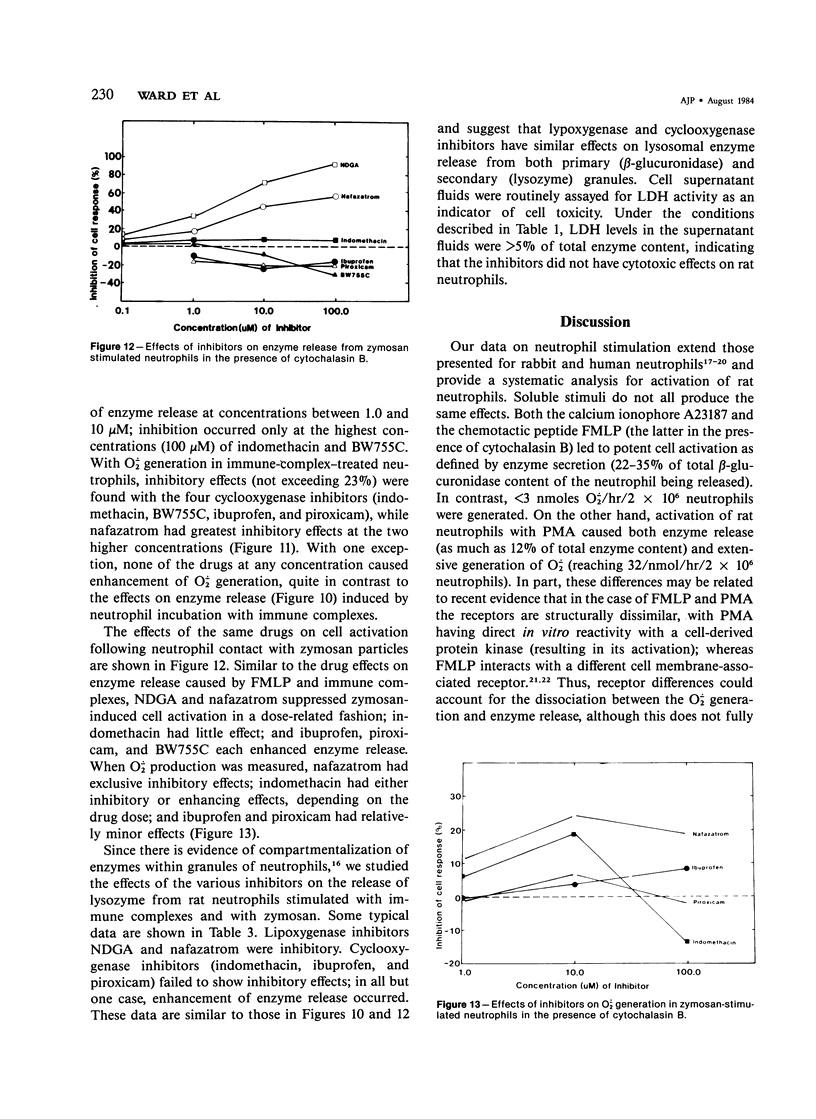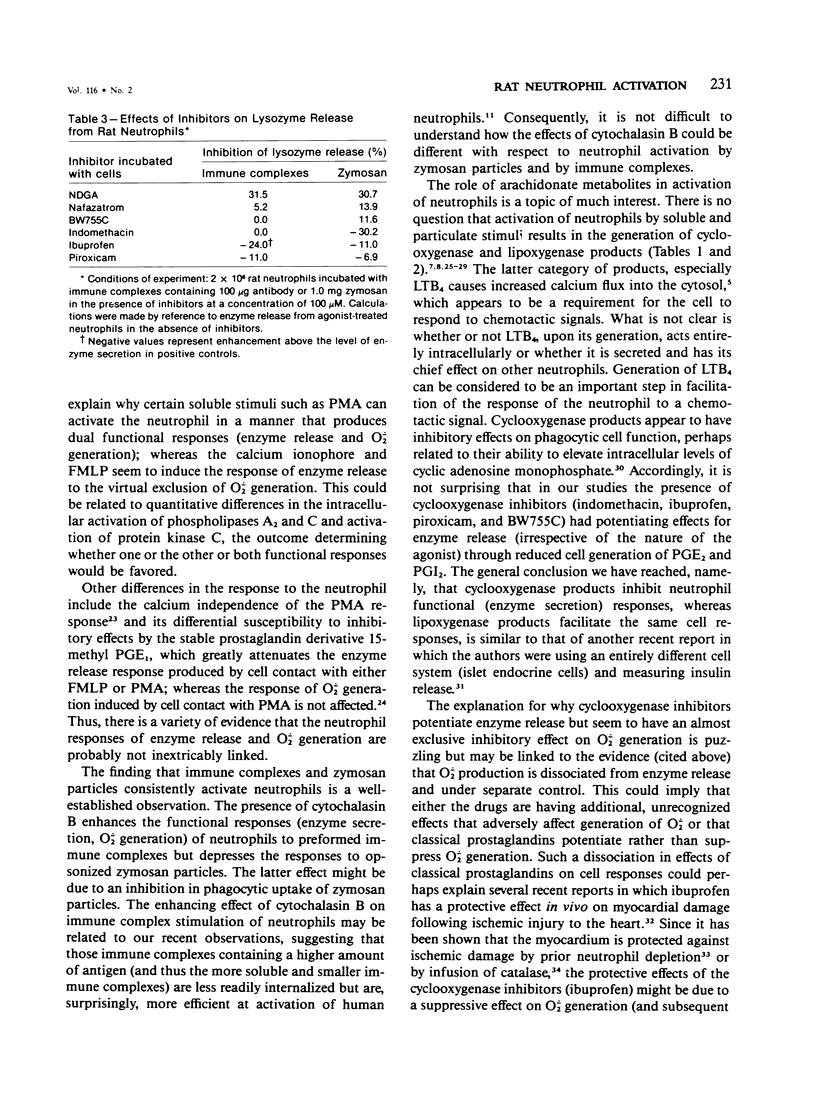Abstract
Activation (defined as lysosomal enzyme secretion and generation of O(2) of rat neutrophils has been measured with the use of varying doses of soluble stimuli (phorbol myristate acetate (PMA); calcium ionophore A23187; and N-formyl-methionyl-leucyl-phenyl-alanine (FMLP] and particulate agents (immune complexes and zymosan particles). With either the calcium ionophore or the chemotactic peptide (FMLP), substantial enzyme release occurred, but the amount of O(2) produced was very small. Cytochalasin B greatly enhanced the enzyme release response to the chemotactic peptide but had little effect on neutrophil responses to other soluble stimuli. The cell response to PMA resulted in the greatest production of O(2) with significant enzyme secretion. When cell stimulation with insoluble stimuli (immune complexes or zymosan particles) was studied, significant amounts of enzyme release occurred in parallel with the generation of substantial amounts of O(2). The presence of cytochalasin B enhanced the cell responses to immune complexes but had an inhibitory effect on zymosan-induced responses. As expected, the amount of lysozyme secreted by stimulated rat neutrophils tended to exceed the amount of beta-glucuronidase released from the same cells. Neutrophil responses were investigated in the presence of drugs that were demonstrated in the rat neutrophil to inhibit either the lipoxygenase or the cyclooxygenase pathway. Inhibitors of the cyclooxygenase pathway (indomethacin, piroxicam, ibuprofen, BW755C), with few exceptions, consistently enhanced the enzyme secretion response, while effects on O(2) generation were less clear-cut but tended to be predominantly inhibitory. Drugs with inhibitory effects on the lipoxygenase pathway (nordihydroguaiaretic acid and nafazatrom) had significant inhibitory effects on both enzyme secretion as well as generation of O(2). These data suggest that activation responses (enzyme secretion and O(2) generation) of rat neutrophils may be dissociated (ie, one not always accompanying the other). Further, it appears that neutrophil activation, as defined by enzyme secretion, is enhanced by products of the lipoxygenase pathway and suppressed by products of the cyclooxygenase pathway. Generation of O(2) is not affected in such a clear-cut manner. Taken together the data suggest that enzyme release and O(2) production by activated rat neutrophils may be under separate control.
Full text
PDF










Selected References
These references are in PubMed. This may not be the complete list of references from this article.
- Abita J. P. Indomethacin is a competitive inhibitor of the binding of the chemotactic peptide formyl-Met-Leu-Phe to human polymorphonuclear leukocytes. Agents Actions. 1981 Dec;11(6-7):610–612. doi: 10.1007/BF01978762. [DOI] [PubMed] [Google Scholar]
- Aswanikumar S., Corcoran B., Schiffmann E., Day A. R., Freer R. J., Showell H. J., Becker E. L. Demonstration of a receptor on rabbit neutrophils for chemotactic peptides. Biochem Biophys Res Commun. 1977 Jan 24;74(2):810–817. doi: 10.1016/0006-291x(77)90375-8. [DOI] [PubMed] [Google Scholar]
- Bass D. A., Thomas M. J., Goetzl E. J., DeChatelet L. R., McCall C. E. Lipoxygenbase-derived products of arachidonic acid mediate stimulation of hexose uptake in human polymorphonuclear leukocytes. Biochem Biophys Res Commun. 1981 May 15;100(1):1–7. doi: 10.1016/s0006-291x(81)80054-x. [DOI] [PubMed] [Google Scholar]
- Baxter M. A., Leslie R. G., Reeves W. G. The stimulation of superoxide anion production in guinea-pig peritoneal macrophages and neutrophils by phorbol myristate acetate, opsonized zymosan and IgG2-containing soluble immune complexes. Immunology. 1983 Apr;48(4):657–665. [PMC free article] [PubMed] [Google Scholar]
- Becker E. L., Sigman M., Oliver J. M. Superoxide production induced in rabbit polymorphonuclear leukocytes by synthetic chemotactic peptides and A23187. Am J Pathol. 1979 Apr;95(1):81–97. [PMC free article] [PubMed] [Google Scholar]
- Borgeat P., Samuelsson B. Arachidonic acid metabolism in polymorphonuclear leukocytes: unstable intermediate in formation of dihydroxy acids. Proc Natl Acad Sci U S A. 1979 Jul;76(7):3213–3217. doi: 10.1073/pnas.76.7.3213. [DOI] [PMC free article] [PubMed] [Google Scholar]
- Castagna M., Takai Y., Kaibuchi K., Sano K., Kikkawa U., Nishizuka Y. Direct activation of calcium-activated, phospholipid-dependent protein kinase by tumor-promoting phorbol esters. J Biol Chem. 1982 Jul 10;257(13):7847–7851. [PubMed] [Google Scholar]
- Estensen R. D., White J. G., Holmes B. Specific degranulation of human polymorphonuclear leukocytes. Nature. 1974 Mar 22;248(446):347–348. doi: 10.1038/248347a0. [DOI] [PubMed] [Google Scholar]
- Fantone J. C., Kinnes D. A. Prostaglandin E1 and prostaglandin I2 modulation of superoxide production by human neutrophils. Biochem Biophys Res Commun. 1983 Jun 15;113(2):506–512. doi: 10.1016/0006-291x(83)91754-0. [DOI] [PubMed] [Google Scholar]
- Fletcher M. P., Seligmann B. E., Gallin J. I. Correlation of human neutrophil secretion, chemoattractant receptor mobilization, and enhanced functional capacity. J Immunol. 1982 Feb;128(2):941–948. [PubMed] [Google Scholar]
- Goldstein I. M., Horn J. K., Kaplan H. B., Weissmann G. Calcium-induced lysozyme secretion from human polymorphonuclear leukocytes. Biochem Biophys Res Commun. 1974 Sep 23;60(2):807–812. doi: 10.1016/0006-291x(74)90312-x. [DOI] [PubMed] [Google Scholar]
- Homma Y., Onozaki K., Hashimoto T., Nagai Y., Takenawa T. Differential activation of phospholipids metabolism by formylated peptide and ionophore A23187 in guinea pig peritoneal macrophages. J Immunol. 1982 Oct;129(4):1619–1626. [PubMed] [Google Scholar]
- Lehmeyer J. E., Snyderman R., Johnston R. B., Jr Stimulation of neutrophil oxidative metabolism by chemotactic peptides: influence of calcium ion concentration and cytochalasin B and comparison with stimulation by phorbol myristate acetate. Blood. 1979 Jul;54(1):35–45. [PubMed] [Google Scholar]
- Leung K. H., Ehrke M. J., Mihich E. Modulation of the development of cell-mediated immunity: possible role of the products of the cyclo-oxygenase and the lipoxygenase pathways of arachidonic acid metabolism. Int J Immunopharmacol. 1982;4(3):195–204. doi: 10.1016/0192-0561(82)90049-2. [DOI] [PubMed] [Google Scholar]
- Lindgren J. A., Hansson G., Samuelsson B. Formation of novel hydroxylated eicosatetraenoic acids in preparations of human polymorphonuclear leukocytes. FEBS Lett. 1981 Jun 15;128(2):329–335. doi: 10.1016/0014-5793(81)80110-x. [DOI] [PubMed] [Google Scholar]
- Marasco W. A., Fantone J. C., Freer R. J., Ward P. A. Characterization of the rat neutrophil formyl peptide chemotaxis receptor. Am J Pathol. 1983 Jun;111(3):273–281. [PMC free article] [PubMed] [Google Scholar]
- Marone G., Thomas L. L., Lichtenstein L. M. The role of agonists that activate adenylate cyclase in the control of cAMP metabolism and enzyme release by human polymorphonuclear leukocytes. J Immunol. 1980 Nov;125(5):2277–2283. [PubMed] [Google Scholar]
- Metz S., VanRollins M., Strife R., Fujimoto W., Robertson R. P. Lipoxygenase pathway in islet endocrine cells. Oxidative metabolism of arachidonic acid promotes insulin release. J Clin Invest. 1983 May;71(5):1191–1205. doi: 10.1172/JCI110868. [DOI] [PMC free article] [PubMed] [Google Scholar]
- Myers R. F., Siegel M. I. Differential effects of anti-inflammatory drugs on lipoxygenase and cyclo-oxygenase activities of neutrophils from a reverse passive Arthus reaction. Biochem Biophys Res Commun. 1983 Apr 29;112(2):586–594. doi: 10.1016/0006-291x(83)91504-8. [DOI] [PubMed] [Google Scholar]
- Naccache P. H., Molski T. F., Becker E. L., Borgeat P., Picard S., Vallerand P., Sha'afi R. I. Specificity of the effect of lipoxygenase metabolites of arachidonic acid on calcium homeostasis in neutrophils. Correlation with functional activity. J Biol Chem. 1982 Aug 10;257(15):8608–8611. [PubMed] [Google Scholar]
- Niedel J. E., Kuhn L. J., Vandenbark G. R. Phorbol diester receptor copurifies with protein kinase C. Proc Natl Acad Sci U S A. 1983 Jan;80(1):36–40. doi: 10.1073/pnas.80.1.36. [DOI] [PMC free article] [PubMed] [Google Scholar]
- Randall R. W., Eakins K. E., Higgs G. A., Salmon J. A., Tateson J. E. Inhibition of arachidonic acid cyclo-oxygenase and lipoxygenase activities of leukocytes by indomethacin and compound BW755C. Agents Actions. 1980 Dec;10(6):553–555. doi: 10.1007/BF02024164. [DOI] [PubMed] [Google Scholar]
- Razin E., Globerson A., Skutelsky E. Indomethacin modulates plasma membrane-associated properties of macrophages. Prostaglandins Leukot Med. 1982 Apr;8(4):301–310. doi: 10.1016/0262-1746(82)90053-1. [DOI] [PubMed] [Google Scholar]
- Romson J. L., Hook B. G., Kunkel S. L., Abrams G. D., Schork M. A., Lucchesi B. R. Reduction of the extent of ischemic myocardial injury by neutrophil depletion in the dog. Circulation. 1983 May;67(5):1016–1023. doi: 10.1161/01.cir.67.5.1016. [DOI] [PubMed] [Google Scholar]
- Romson J. L., Hook B. G., Rigot V. H., Schork M. A., Swanson D. P., Lucchesi B. R. The effect of ibuprofen on accumulation of indium-111-labeled platelets and leukocytes in experimental myocardial infarction. Circulation. 1982 Nov;66(5):1002–1011. doi: 10.1161/01.cir.66.5.1002. [DOI] [PubMed] [Google Scholar]
- Rubin R. P., Sink L. E., Schrey M. P., Day A. R., Liao C. S., Freer R. J. Secretagogues for lysosomal enzyme release as stimulants of arachidonyl phosphatidylinositol turnover in rabbit neutrophils. Biochem Biophys Res Commun. 1979 Oct 29;90(4):1364–1370. doi: 10.1016/0006-291x(79)91186-0. [DOI] [PubMed] [Google Scholar]
- Schiffmann E., Corcoran B. A., Wahl S. M. N-formylmethionyl peptides as chemoattractants for leucocytes. Proc Natl Acad Sci U S A. 1975 Mar;72(3):1059–1062. doi: 10.1073/pnas.72.3.1059. [DOI] [PMC free article] [PubMed] [Google Scholar]
- Showell H. J., Freer R. J., Zigmond S. H., Schiffmann E., Aswanikumar S., Corcoran B., Becker E. L. The structure-activity relations of synthetic peptides as chemotactic factors and inducers of lysosomal secretion for neutrophils. J Exp Med. 1976 May 1;143(5):1154–1169. doi: 10.1084/jem.143.5.1154. [DOI] [PMC free article] [PubMed] [Google Scholar]
- Sklar L. A., Jesaitis A. J., Painter R. G., Cochrane C. G. Ligand/receptor internalization: a spectroscopic analysis and a comparison of ligand binding, cellular response, and internalization by human neutrophils. J Cell Biochem. 1982;20(2):193–202. doi: 10.1002/jcb.240200210. [DOI] [PubMed] [Google Scholar]
- Smolen J. E., Weissmann G. Effects of indomethacin, 5,8,11,14-eicosatetraynoic acid, and p-bromophenacyl bromide on lysosomal enzyme release and superoxide anion generation by human polymorphonuclear leukocytes. Biochem Pharmacol. 1980 Feb 15;29(4):533–538. doi: 10.1016/0006-2952(80)90373-1. [DOI] [PubMed] [Google Scholar]
- Stenson W. F., Parker C. W. Metabolism of arachidonic acid in ionophore-stimulated neutrophils. Esterification of a hydroxylated metabolite into phospholipids. J Clin Invest. 1979 Nov;64(5):1457–1465. doi: 10.1172/JCI109604. [DOI] [PMC free article] [PubMed] [Google Scholar]
- Walsh C. E., Dechatelet L. R., Thomas M. J., O'Flaherty J. T., Waite M. Effect of phagocytosis and ionophores on release and metabolism of arachidonic acid from human neutrophils. Lipids. 1981 Feb;16(2):120–124. doi: 10.1007/BF02535685. [DOI] [PubMed] [Google Scholar]
- Ward P. A., Duque R. E., Sulavik M. C., Johnson K. J. In vitro and in vivo stimulation of rat neutrophils and alveolar macrophages by immune complexes. Production of O-2 and H2O2. Am J Pathol. 1983 Mar;110(3):297–309. [PMC free article] [PubMed] [Google Scholar]
- Weiss S. J., Ward P. A. Immune complex induced generation of oxygen metabolites by human neutrophils. J Immunol. 1982 Jul;129(1):309–313. [PubMed] [Google Scholar]
- Williams L. T., Snyderman R., Pike M. C., Lefkowitz R. J. Specific receptor sites for chemotactic peptides on human polymorphonuclear leukocytes. Proc Natl Acad Sci U S A. 1977 Mar;74(3):1204–1208. doi: 10.1073/pnas.74.3.1204. [DOI] [PMC free article] [PubMed] [Google Scholar]


